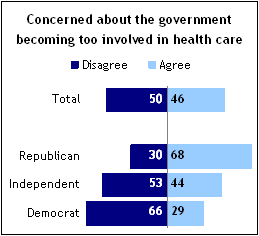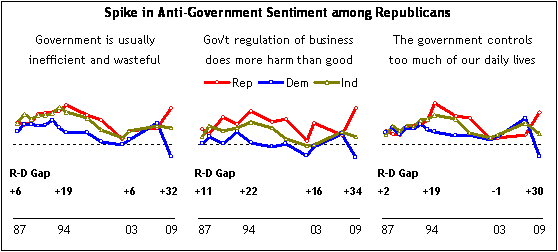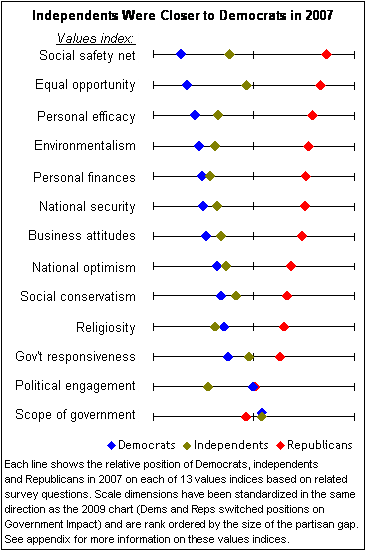
The 2009 political values study finds that the deep partisan fissures in values and core attitudes have continued to widen. Across 48 value questions asked consistently over the past 22 years, the average difference between the opinions of Democrats and Republicans has grown from nine percentage points as recently as 1997 to a new high of 16 points today. In many cases, already existing partisan divides have increased in size. In other cases, the change in administration has caused Republican and Democratic opinions about government to diverge. The net effect is a widening difference of opinion between the two constituencies.
As they grow in numbers, the role of political independents becomes increasingly important. As a group, independents remain difficult to pin down. They are clearly left-of-center when it comes to religiosity and issues of moral values – independents’ views on homosexuality, gender roles, censorship and the role of religion in politics are clearly closer to those of Democrats than Republicans. They also tend to have more in common with Democrats with respect to foreign policy and military assertiveness. At the same time, their views on broader economic issues have taken a turn to the right in the latest survey. In particular, they are now more conservative on questions relating to the role of government in providing a social safety net and the government’s overall effectiveness and scope. They are also less aligned with Democrats than at any point in the past in their attitudes toward big business.
Some of these changes among independents undoubtedly reflect their changing political composition: As Republicans depart from the ranks of the GOP and become independents they bring a more conservative political ideology along with them. Yet there is not a consistent rightward drift to the views of independents, and as in past values surveys, independents’ opinions typically fall somewhere between those of Republicans and Democrats.
The Biggest Partisan Divides in 2009

The starkest shift in partisan values in 2009 comes on values items related to government effectiveness and impact. The single widest gap in opinions among Republicans and Democrats comes in response to the statement: “I am concerned about the government becoming too involved in healthcare.” Just over two-thirds (68%) of Republicans agree, compared with just 29% of Democrats – a 39-point partisan gap.
More generally, Republicans express much greater skepticism about government than they did two years ago. In fact, by many measures Republicans feel as negatively toward government today as they did in 1994, just months before the GOP ended the Democrats’ four decades of control of Congress. Three-quarters of Republicans (75%) today agree that “government regulation of business usually does more harm than good” – up from 57% two years ago. About the same number (74%) say when something is run by the government “it is usually inefficient and wasteful,” up from 61% in 2007. In both cases, Republican skepticism is near its previous peak in 1994.
Meanwhile, Democrats feel as positively about government as at any previous point in the 22-year history of this study. Just 41% of Democrats believe government regulation of business does more harm than good; two years ago, as many Democrats as Republicans (57% each) expressed this view. Notably, only 42% of Democrats believe the government is usually inefficient and wasteful, the lowest percentage in 22 years.

The net effect of these changes is a level of polarization over government never before seen in the history of this study. There is at least a 30-point gap between the percentage of Democrats and Republicans agreeing with each of these questions. Independents fall squarely in the center on these items.
One of the widest partisan divides among the values questions is over whether “the government should help more needy people even if it means going deeper into debt.” Nearly two-thirds of Democrats (65%) agree, compared with just 29% of Republicans – a 36-point gap. Unlike the views about government described above, where partisan divisions ebb and flow depending on which party controls the White House, this has been a long-standing difference of opinion between Democrats and Republicans. In fact, over the 22-year course of this project, the gap between Democrats and Republicans on this question has never been below 20 percentage points. But the 36-point gap in 2009 is the largest on record, reflecting a slow but steady widening of the partisan divide. The pattern is virtually identical on other items related to the government’s responsibility to provide a social safety net for those in need.

The overall balance of public opinion on the government’s responsibility to provide for the needy has shifted to the right in the latest survey. The share of Americans overall who favor helping more needy people even if it means greater debt has fallen from 54% in 2007 to 48% today, and there is a comparable drop in the share who say the government should guarantee every citizen enough to eat and a place to sleep (from 69% in 2007 to 62% today). This rightward shift is starkest among independents. Today, just 43% of independents say the government should help more needy people even if it means going deeper into debt, down 14 points since 2007. And over this period the number of independents who favor guaranteeing food and shelter for all has fallen 13 points from 71% to 58%.
Independents, on balance, now share more in common with Republicans than Democrats when it comes to the social safety net, and both independents and Republicans express more opposition to this kind of government role than at any point since 1994.
There also are substantial partisan divides over the government’s role in improving the position of minorities, protecting the environment, and providing for national security, as well as over the value of labor unions to working Americans.
More than three times as many Democrats as Republicans (45% vs. 13%) agree that “we should make every possible effort to improve the position of blacks and other minorities, even if means giving them preferential treatment.” As with government assistance for the poor, this has long been an issue on which Democrats and Republicans have differed, but the gap is as large today as it has ever been.

When it comes to environmental protection, Democrats almost universally agree that “there needs to be stricter laws and regulations to protect the environment” (94% agree, 6% disagree); Republican opinion is less universal (64% agree, 33% disagree). The increased political polarization of environmental attitudes has been driven almost entirely by declining support for further environmental protection among Republicans. When the question was first asked in 1992, 86% of Republicans favored stricter laws and regulations to protect the environment, just seven points fewer than among Democrats at that time.
Foreign policy also makes the list of largest partisan divides: Republicans are 32 percentage points more likely than Democrats (75% vs. 43%) to say they believe the best way to ensure peace is through military strength. The parties have always differed on this question, but, like others, the gap is continuing to grow.
Republicans and Democrats have long differed over the importance of labor unions, but again the gap is larger today than ever before, due largely to dropping union support among Republicans. Currently, 80% of Democrats say that labor unions are necessary to protect the working person – a figure largely unchanged over the past 22 years. But for the first time, fewer than half (44%) of Republicans take this view, down from 53% just two years ago. This makes the partisan gap over unions (36 percentage points) one of the largest in the survey.
Democrats are also far more likely than Republicans to say it’s really true that the rich just get richer while the poor get poorer (84% vs. 53%). Despite the recent economic crisis involving growing unemployment, falling housing prices and scandals about executive salaries at some of America’s largest companies, opinions on this item have not moved.
This focus on the questions that demonstrate the largest partisan divides highlights the broad drifting apart of the political parties. But there are a number of other areas in which partisanship is less of a factor. And more importantly, the relative position of independents, particularly as they grow in size, is of at least as much importance as the relative gaps between Republicans and Democrats.
Independents’ Values

On the vast majority of political and social values included in the study, independents fall somewhere between Republicans and Democrats. But the proximity of the opinions of independents to the opinions of Democrats and Republicans has shifted over the years.
There are three broad areas where the views of independents today are closer to those of Republicans than to Democrats: the social safety net; the government’s role in ensuring equal opportunity for all Americans; and public confidence in the electoral process and the responsiveness of elected officials. This is seen using a series of indices constructed from survey questions on each topic.
Independents are consistently skeptical about the electoral process and the responsiveness of officials; with a new Democratic administration, Republicans have now come to share this perspective. When George W. Bush was president, it was the Democrats who shared the independents’ skepticism on this dimension. The views of independents about the social safety net have taken a conservative turn over the last few years, now bringing them closer to those of Republicans.
On three other value dimensions, the views of independents are closer to Democrats than Republicans. In an index of questions about personal religiosity, independents and Democrats express virtually identical views. For much of the past 22 years, independents were the least religious of the three groups, but religiosity among Democrats has declined substantially since the late 1990s.
On a related index of questions about social and moral values, independents also share more in common with Democrats, and have consistently done so over the years. The third area where independents’ values come closer to those of Democrats is national security and foreign policy assertiveness. The opinions of independents and Democrats in this area have tracked closely in recent years, while Republicans have increasingly come to support a more assertive approach to foreign policy and national security.
Independents’ attitudes fall squarely in between those of Democrats and Republicans on most other value dimensions. The one exception is an index of political interest and engagement, on which independents score far lower than either Democrats or Republicans.
A Shift Since 2007

In the 2007 values survey, independents shared more in common with Democrats on nine of the 13 value dimensions and there were no dimensions where independents were closer to Republicans. Independents today continue to share more in common with Democrats on national security, religiosity and social conservatism, but they have moved away from Democrats when it comes to attitudes about business, environmentalism, personal efficacy (whether individuals have the power to get ahead) and the social safety net.
The 2007 survey was not an anomaly in this respect. The following page provides the full historical perspective on these 13 broad dimensions of core political attitudes and beliefs. The relative proximity of independents and Democrats in many of the charts – along with the changes in 2009 – is clearly evident.
The Values Indices
To provide a summary measure of some of the areas covered by the values study, questions about a related topic are combined into indices using a technique called factor analysis. This statistical procedure combine questions that are related to a common concept (e.g., religiosity) into a single scale, giving each question a weight in the index that reflects how similar it is to the concept being measure. Each person in the survey is assigned a score on the scale that summarizes their answers to these related questions. These scores can then be aggregated for comparisons over time or across groups (e.g., between Democrats and Republicans).
The following pages show the full 22 year trend for 12 values indices first developed in 1987 (and a 17 year trend for an index on environmentalism developed in 1992) among Republicans, Democrats and independents. Each index is based on between two and five individual survey questions that are highly correlated with each other. For some questions, agree and disagree answers were reversed to make the index internally consistent (this is noted in italics following each question). The percentage who agreed or disagreed with each question in 2009 is shown for reference purposes. The factor indices take into account the full variance on each question, including strength of agreement.
To view the Values Indices go to page 105 of the Complete Report PDF.